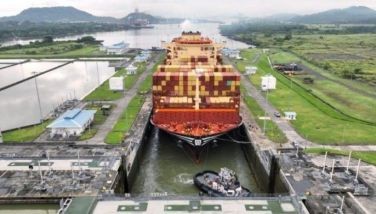A nation at risk

UN and other sources make the Asia-Pacific region the world’s most disaster-prone area in the world. They say that in the past decade, a person living in Asia and the Pacific was most likely to be affected by natural disasters almost nine times more than a person living in North America and 67 times more likely than a person in Europe.
Some months ago, a news article about rising sea levels and Super Typhoon Yolanda caught my attention. It said the Philippines posted the highest average increase in sea levels since 1901 – at 60 centimeters – three times the global average. Experts say we can expect to see stronger typhoons and storm surges in the future bringing more death and destruction to our country.
So how do we cope with this new reality – the so-called “new normal”? Better disaster preparedness and improved climate change adaptation are certainly part of the answer. “Building back better” and “early recovery and rehabilitation” will help. But we have to do more. We need to transform our business models and mindsets regarding our underlying vulnerabilities if we are to create a truly resilient society.
Let me elaborate. Our vulnerability to natural hazards stems from two sources – our geography and our economy.
The Philippines lies astride warm waters of the western Pacific where a large part of the world’s cyclones form that bring an average of 20 typhoons a year to our country. The Philippines rests on the Pacific’s earthquake and volcanic Ring of Fire and there are 220 volcanoes in the country, 21 of which are active. El Niño occurrences induce drought in many parts of the country, posing a serious problem for agriculture and water supply. Climate change has made things worse by amplifying the adverse effects of natural hazards and making the weather more unpredictable.
Over the years our pattern of development has also increased our exposure and vulnerability to natural disasters. Between 1980 and 2010 – a period of 30 years – our population doubled from 47 million to 94 million. Poverty remains high – at 25-26 percent of the population. So does income inequality, with incomes of the rich rising much faster than those in the middle and low-income groups. Moreover, almost one in every two Filipinos or 49 percent of our population now lives in cities compared to one in three back in the ’60s. By 2030, our urban population is expected to rise to 77 percent.
Building a “resilient economy” and “resilient society” able to cope with and recover from the shock inflicted by these occurrences – be they caused by human folly such as wanton financial practices, or by nature such as typhoons, earthquakes, floods and drought – have today become the new reality that policy makers in ASEAN have to deal with.
ASEAN has had almost two decades experience in building resilience to economic crisis since the 1997 Asian crisis. As ASEAN progresses towards an ASEAN community there is expectation of closer economic policy coordination among its members and joint effort to deal with economic shocks of which the Chiang Mai Initiative is seen as a portent of things to come.
By contrast, embedding resilience to natural disaster in policy making is of recent vintage. Yet it is increasingly recognized that the economic consequences of natural disasters last longer and disproportionately affect the poor and disadvantaged community. They exacerbate poverty and inequality.
For economies like the Philippines, the challenge of planning for resiliency requires, most of all, a transformation in thinking and attitude from planning to execution at community, local government and national government levels. For governments faced with many competing priorities for not limitless resources, it requires a sea change in thinking to allocate funds otherwise spent on critical social spending or infrastructure for measures to respond to an event which may or may not happen for a while. This despite the fact that for every dollar invested in prevention and resilience between $4 and $7 are saved in disaster response, according to UNDP and the California Emergency Management Agency.
The fact that natural disasters draws international attention and, therefore, more financial resources makes it even more tempting to take a wait and see attitude. This is why I believe it is critical to develop a comprehensive disaster database to assist evidence based policy making for contingencies, risk reduction, insurance, self-insurance, and disaster response. Likewise, working with international donors and funders before disaster strikes could mobilize external assistance for risk reduction, which is likely to earn a higher return than emergency help after the fact.
We have a number of best practices to share at the community and local government level. But the challenge is enormous particularly when it comes to transformative thinking. Let me illustrate. Schools have opened in the most heavily damaged areas of Leyte and Samar even though hardly any repairs have been done to destroyed classrooms. Unfortunately, for some of those classrooms that have been rebuilt, including those from donors, these have been reconstructed in the exact same location and architectural design as those that were destroyed by the typhoon. In one school in Leyte, there is a school building built in 1994 with JICA funds and design. It was relatively unscathed by Yolanda compared to the surrounding newly built classrooms. It shows that technology to build typhoon resistant classrooms was already in existence 20 years ago. In another example, in Tacloban City, where those by now frequently shown pictures of ships washed ashore are located, shanties have again sprouted around them despite a sign that says “No Build Zone”.
On July 9-10, the Carlos P. Romulo Foundation for Peace and Development, the Zuellig Family Foundation and the Manila Observatory in cooperation with PLDT, AIG Philippines Insurance and Federal Phoenix Assurance will host a conference on resilience. We envision partnerships with the private sector such as the recent three year commitment of San Miguel Corporation, NGOs, the Church and multilateral organizations. Aware that one conference cannot achieve our objectives, it is our intention to have a three year program of workshops and pilot programs in selected municipalities.
Beyond better disaster preparedness, risk reduction and climate change adaptation, the conference will give particular attention to the innovative and transformative changes needed to build resilience.
- Latest
- Trending




























